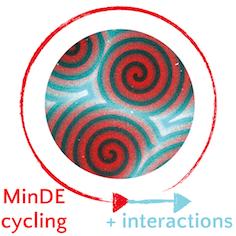A diffusiophoretic mechanism for ATP-driven transport without motor proteins
Beatrice Ramm, Andriy Goychuk, Alena Khmelinskaia, Philipp Blumhardt, Hiromune Eto, Kristina A. Ganzinger, Erwin Frey & Petra Schwille
 Cells must ensure that molecular cargoes are delivered in a timely manner to their intended destinations in order to perform their biological functions. To do so, cells employ sophisticated transport mechanisms that are usually based on specific interactions, where energy-consuming motor proteins convey cargo to its destination. In a joint effort between experiment and theory, we have uncovered an additional mode of transport driven by pattern-forming reaction-diffusion systems. We demonstrated that ATP-driven protein patterns can induce diffusiophoresis of other, completely unrelated biomolecules by a genuinely nonequilibrium coupling. Our findings indicate a rudimentary and purely physical transport process so far not described in biological systems, which does not rely on specific interactions and is therefore robust against mutations.
Cells must ensure that molecular cargoes are delivered in a timely manner to their intended destinations in order to perform their biological functions. To do so, cells employ sophisticated transport mechanisms that are usually based on specific interactions, where energy-consuming motor proteins convey cargo to its destination. In a joint effort between experiment and theory, we have uncovered an additional mode of transport driven by pattern-forming reaction-diffusion systems. We demonstrated that ATP-driven protein patterns can induce diffusiophoresis of other, completely unrelated biomolecules by a genuinely nonequilibrium coupling. Our findings indicate a rudimentary and purely physical transport process so far not described in biological systems, which does not rely on specific interactions and is therefore robust against mutations.
Specifically, we investigated the E. coli MinDE reaction-diffusion system, a model for self-organized pattern formation that has been studied in depth for nearly 20 years. It has been widely believed that the sole purpose of the oscillations generated by MinDE in the cell is the positioning of the FtsZ inhibitor MinC at the cell poles, constraining FtsZ to midcell. While recent experiments have shown that the MinDE system can also regulate other unrelated membrane-bound proteins by non-specific means, the broader biological implications, and more importantly, the underlying physics remained elusive.
To close this gap and explain how MinDE patterns may induce active transport of biomolecules, we set up a highly controllable in vitro platform. In collaboration with the Lab of Petra Schwille, we reconstituted MinDE pattern formation on artificial membranes and generated a modular synthetic cargo: a DNA-origami scaffold with multiple streptavidin building blocks. Using these nanostructures, we demonstrated that transport depends on the effective size of the cargo (while also working for small molecules like individual streptavidin) and, intriguingly, that MinDE can even sort molecules according to size. These highly controllable experiments allowed us to determine the underlying transport mechanism by means of a theoretical analysis, where we tested the predictions of multiple candidate mechanisms either based on thermal equilibrium effects or genuine non-equilibrium dynamics. We found that the experiments can only be explained by diffusiophoresis, driven by non-equilibrium currents of ATP-consuming active proteins. Such non-equilibrium currents naturally occur in pattern-forming systems in the form of reactive currents that build up gradients and diffusive currents. In our case, diffusive currents on the membrane couple to the cargo via an effective mesoscopic friction, thus driving diffusiophoretic transport.
Diffusiophoresis was first described by Derjaguin 50 years ago and has long been demonstrated to occur in colloidal suspensions. With other physicochemical mechanisms such as liquid-liquid phase separation taking the spotlight in biology, diffusiophoresis could represent a new kind of generic transport mechanism in cells never described so far in biological settings. This mechanism could be especially important in simpler biological systems, such as prokaryotes and early life forms, as they lack(ed) the highly complex motor proteins present in higher organisms.

